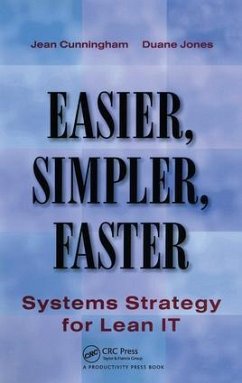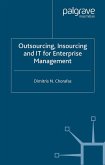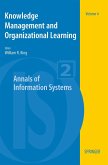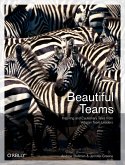- Gebundenes Buch
- Merkliste
- Auf die Merkliste
- Bewerten Bewerten
- Teilen
- Produkt teilen
- Produkterinnerung
- Produkterinnerung
For your lean transformation to be successful, your IT system must support it! To enhance and sustain its lean journey, a company must implement information systems that fully support and enhance the lean initiative. In Easier, Simpler, Faster: Systems Strategy for Lean IT, Jean Cunningham and Duane Jones introduce the case study of an actual lean implementation involving the IT system of a mid-size manufacturer, highlighting the IT challenges that the manufacturer faced during the lean transformation. This book will provide you with a broader vision as well as a path to what a lean system environment will look like for your company.…mehr
Andere Kunden interessierten sich auch für
![Securing the Future Through Sustainability, Health, Education, and Technology Securing the Future Through Sustainability, Health, Education, and Technology]() Securing the Future Through Sustainability, Health, Education, and Technology199,99 €
Securing the Future Through Sustainability, Health, Education, and Technology199,99 €![Outsourcing Insourcing and It for Enterprise Management Outsourcing Insourcing and It for Enterprise Management]() Dimitris N. ChorafasOutsourcing Insourcing and It for Enterprise Management75,99 €
Dimitris N. ChorafasOutsourcing Insourcing and It for Enterprise Management75,99 €![Digital Transformation Roadmap Digital Transformation Roadmap]() Hamed TaherdoostDigital Transformation Roadmap140,99 €
Hamed TaherdoostDigital Transformation Roadmap140,99 €![Diamonds Are Forever, Computers Are Not: Economic and Strategic Management in Computing Markets Diamonds Are Forever, Computers Are Not: Economic and Strategic Management in Computing Markets]() Shane GreensteinDiamonds Are Forever, Computers Are Not: Economic and Strategic Management in Computing Markets110,99 €
Shane GreensteinDiamonds Are Forever, Computers Are Not: Economic and Strategic Management in Computing Markets110,99 €![Knowledge Management and Organizational Learning Knowledge Management and Organizational Learning]() William R. King (ed.)Knowledge Management and Organizational Learning215,99 €
William R. King (ed.)Knowledge Management and Organizational Learning215,99 €![Beautiful Teams Beautiful Teams]() Andrew StellmanBeautiful Teams39,99 €
Andrew StellmanBeautiful Teams39,99 €![Towards Knowledge Portals Towards Knowledge Portals]() Brian DetlorTowards Knowledge Portals108,99 €
Brian DetlorTowards Knowledge Portals108,99 €-
-
-
For your lean transformation to be successful, your IT system must support it! To enhance and sustain its lean journey, a company must implement information systems that fully support and enhance the lean initiative. In Easier, Simpler, Faster: Systems Strategy for Lean IT, Jean Cunningham and Duane Jones introduce the case study of an actual lean implementation involving the IT system of a mid-size manufacturer, highlighting the IT challenges that the manufacturer faced during the lean transformation. This book will provide you with a broader vision as well as a path to what a lean system environment will look like for your company.
Hinweis: Dieser Artikel kann nur an eine deutsche Lieferadresse ausgeliefert werden.
Hinweis: Dieser Artikel kann nur an eine deutsche Lieferadresse ausgeliefert werden.
Produktdetails
- Produktdetails
- Verlag: Taylor & Francis
- Seitenzahl: 176
- Erscheinungstermin: 1. Februar 2007
- Englisch
- Abmessung: 229mm x 162mm x 17mm
- Gewicht: 417g
- ISBN-13: 9781563273537
- ISBN-10: 1563273535
- Artikelnr.: 22522061
- Herstellerkennzeichnung
- Libri GmbH
- Europaallee 1
- 36244 Bad Hersfeld
- gpsr@libri.de
- Verlag: Taylor & Francis
- Seitenzahl: 176
- Erscheinungstermin: 1. Februar 2007
- Englisch
- Abmessung: 229mm x 162mm x 17mm
- Gewicht: 417g
- ISBN-13: 9781563273537
- ISBN-10: 1563273535
- Artikelnr.: 22522061
- Herstellerkennzeichnung
- Libri GmbH
- Europaallee 1
- 36244 Bad Hersfeld
- gpsr@libri.de
Duane Jones has worn several hats at Lantech, and has served the companyas material handler, engineering change coordinator, and productionscheduler. When Lantech decided to go lean, he became amember of the kaizen team for the lean effort. After implementingLantech's ERP system in 1995, he learned to program (without any previousexperience) and subsequently trained others in the customizationof the new ERP system. Duane then became Lantech's IS TeamLeader, a position he holds to this day. In this capacity, he is responsiblefor hardware, software, and application integration in our company.He has served as consultant to Lantech's European affiliateduring its ERP implementation in 2003 and continues to apply leanprinciples directly within IS as well as in any IS customer projects.While at Lantech, Jean Cunningham was the company CFO andresponsible for corporate services, HR, accounting, information systems,telecom, facilities, and many of the com pany's continuousimprovement activities until 1999. Fluid in project responsibilities,she was appointed project sponsor for implementation of the ERPsystem in 1995 and was also involved with Lantech's very first m anufacturingkaizen events in 1992, geared to im plem ent lean on thefactory shop floor. After leaving Lantech, Jean assumed a similar leanleader position while serving as CFO for a door manufacturing companythat adopted lean as a business strategy. Jean frequently providesconsulting services to companies interested in lean manufacturing, ISimplementation in a lean environment, and lean accounting.
Acknowledgments
Introduction
Lantech, Lean, and IS: Why This Book Was Written
Beginning Your Journey: IS, IT, and ERP
All Value Streams Are Created Equal
Overview
Conclusion
Chapter 1: Lean Basics to Define Your Custom er
Eliminate Wastes, and Align IS
The Five Lean Principles
The Seven Deadly Wastes
Kaizen and Kaizen Events
Aligning IS to
Activities
Thirteen IS Guiding Principles for a Lean Environment
Chapter 2: Applying Standardization
Information System s
Applying Standardization to Hardware and Software
Hardware Madness
Software Galore
ERP in Name Only
Hardware Benefits from Standardization
Software Benefits from Standardization
Doing More with Less, Faster and Cheaper
Benefits from Using a Common ERP System
Chapter 3: Integrating Your Order Entry into
Information Highway
Modifying ERP to Handle Order Entry
Every Employee Sees the Customer Order
Handling Incomplete Customer Orders
Making Your Office Lean
Less Paper/Immediate Access
Hold That Order!
From Lead to Quote to Order
Scheduling an Order to the Floor
Chapter 4: Selecting, Enabling, and
Your ERP System
Base Product Definition
Technology and Business Preferences
Use Business People with Lean Backgrounds to Find
New ERP System
Skip the ERP Product Sales Talk and Go Directly
the Technicians
The Role of End User Participation
Finalizing Our ERP Choice
Managing Your ERP
Implementing a Vanilla Version
Customizing
Customizing ERP after Implementation
The Power of Training and Keeping Programmers on Staff
Chapter 5: Kanban: Reducing Inventory and
Pull with Suppliers
Kanban Basics
Benefits of Less Inventory
MRP Produces More Inventory, Less Flexibility
The Kanban Process Begins to Open Doors
Kanban Reduces Inventory, Eliminates Waste,
Improves Savings
Integrating the Kanban Process into the ERP System
Creating Self
Billing Invoices
Kanban Builds Stronger Supplier Relationships
Inventory Accuracy Is Less Critical with a Kanban System
Chapter 6: Reshuffling MRP to Align with Kanban and Lean
Role of MRP in Lean
The Pre
MRP Program
MRP Benefits
MRP No Longer Manages You
Chapter 7: Mission to Go Live
Building Teams
Overcoming Barriers
The Business Process Kaizen Team's Strategic Project
The BPK Team Becomes the New ERP Team
Choosing a Consultantd Creating
Implementation Team
Managing the Implementation
Going Live
Strike for the Heart
The Challenge of Using Fewer Reports
Importance of Teams in Building a Lean Culture
Chapter 8: Capturing, Managing, and Sharing Information
Who Sees the Information?
Benefits of Open Sharing of Information
Example of Easy Access
Programming a Preorder Screen
Open Information Builds Trust and a Common Culture
Use Information as a Tool Throughout Your Business
The New IS Role in Supporting Lean
Chapter 9: Lean Accounting System s
The Role of Reports in Lean
Standard Cost Accounting
Plain English Financial Statement
Putting Financial Statements in the Hands of the Users
Impact of Kanban on Accounts Payable Functions
Standard Allocations
Appendix I: Seven S teps to Eliminating Standard Cost from an Information System
Appendix II: The Thirteen Guiding
System Principles
Index
About the Authors.
Introduction
Lantech, Lean, and IS: Why This Book Was Written
Beginning Your Journey: IS, IT, and ERP
All Value Streams Are Created Equal
Overview
Conclusion
Chapter 1: Lean Basics to Define Your Custom er
Eliminate Wastes, and Align IS
The Five Lean Principles
The Seven Deadly Wastes
Kaizen and Kaizen Events
Aligning IS to
Activities
Thirteen IS Guiding Principles for a Lean Environment
Chapter 2: Applying Standardization
Information System s
Applying Standardization to Hardware and Software
Hardware Madness
Software Galore
ERP in Name Only
Hardware Benefits from Standardization
Software Benefits from Standardization
Doing More with Less, Faster and Cheaper
Benefits from Using a Common ERP System
Chapter 3: Integrating Your Order Entry into
Information Highway
Modifying ERP to Handle Order Entry
Every Employee Sees the Customer Order
Handling Incomplete Customer Orders
Making Your Office Lean
Less Paper/Immediate Access
Hold That Order!
From Lead to Quote to Order
Scheduling an Order to the Floor
Chapter 4: Selecting, Enabling, and
Your ERP System
Base Product Definition
Technology and Business Preferences
Use Business People with Lean Backgrounds to Find
New ERP System
Skip the ERP Product Sales Talk and Go Directly
the Technicians
The Role of End User Participation
Finalizing Our ERP Choice
Managing Your ERP
Implementing a Vanilla Version
Customizing
Customizing ERP after Implementation
The Power of Training and Keeping Programmers on Staff
Chapter 5: Kanban: Reducing Inventory and
Pull with Suppliers
Kanban Basics
Benefits of Less Inventory
MRP Produces More Inventory, Less Flexibility
The Kanban Process Begins to Open Doors
Kanban Reduces Inventory, Eliminates Waste,
Improves Savings
Integrating the Kanban Process into the ERP System
Creating Self
Billing Invoices
Kanban Builds Stronger Supplier Relationships
Inventory Accuracy Is Less Critical with a Kanban System
Chapter 6: Reshuffling MRP to Align with Kanban and Lean
Role of MRP in Lean
The Pre
MRP Program
MRP Benefits
MRP No Longer Manages You
Chapter 7: Mission to Go Live
Building Teams
Overcoming Barriers
The Business Process Kaizen Team's Strategic Project
The BPK Team Becomes the New ERP Team
Choosing a Consultantd Creating
Implementation Team
Managing the Implementation
Going Live
Strike for the Heart
The Challenge of Using Fewer Reports
Importance of Teams in Building a Lean Culture
Chapter 8: Capturing, Managing, and Sharing Information
Who Sees the Information?
Benefits of Open Sharing of Information
Example of Easy Access
Programming a Preorder Screen
Open Information Builds Trust and a Common Culture
Use Information as a Tool Throughout Your Business
The New IS Role in Supporting Lean
Chapter 9: Lean Accounting System s
The Role of Reports in Lean
Standard Cost Accounting
Plain English Financial Statement
Putting Financial Statements in the Hands of the Users
Impact of Kanban on Accounts Payable Functions
Standard Allocations
Appendix I: Seven S teps to Eliminating Standard Cost from an Information System
Appendix II: The Thirteen Guiding
System Principles
Index
About the Authors.
Acknowledgments
Introduction
Lantech, Lean, and IS: Why This Book Was Written
Beginning Your Journey: IS, IT, and ERP
All Value Streams Are Created Equal
Overview
Conclusion
Chapter 1: Lean Basics to Define Your Custom er
Eliminate Wastes, and Align IS
The Five Lean Principles
The Seven Deadly Wastes
Kaizen and Kaizen Events
Aligning IS to
Activities
Thirteen IS Guiding Principles for a Lean Environment
Chapter 2: Applying Standardization
Information System s
Applying Standardization to Hardware and Software
Hardware Madness
Software Galore
ERP in Name Only
Hardware Benefits from Standardization
Software Benefits from Standardization
Doing More with Less, Faster and Cheaper
Benefits from Using a Common ERP System
Chapter 3: Integrating Your Order Entry into
Information Highway
Modifying ERP to Handle Order Entry
Every Employee Sees the Customer Order
Handling Incomplete Customer Orders
Making Your Office Lean
Less Paper/Immediate Access
Hold That Order!
From Lead to Quote to Order
Scheduling an Order to the Floor
Chapter 4: Selecting, Enabling, and
Your ERP System
Base Product Definition
Technology and Business Preferences
Use Business People with Lean Backgrounds to Find
New ERP System
Skip the ERP Product Sales Talk and Go Directly
the Technicians
The Role of End User Participation
Finalizing Our ERP Choice
Managing Your ERP
Implementing a Vanilla Version
Customizing
Customizing ERP after Implementation
The Power of Training and Keeping Programmers on Staff
Chapter 5: Kanban: Reducing Inventory and
Pull with Suppliers
Kanban Basics
Benefits of Less Inventory
MRP Produces More Inventory, Less Flexibility
The Kanban Process Begins to Open Doors
Kanban Reduces Inventory, Eliminates Waste,
Improves Savings
Integrating the Kanban Process into the ERP System
Creating Self
Billing Invoices
Kanban Builds Stronger Supplier Relationships
Inventory Accuracy Is Less Critical with a Kanban System
Chapter 6: Reshuffling MRP to Align with Kanban and Lean
Role of MRP in Lean
The Pre
MRP Program
MRP Benefits
MRP No Longer Manages You
Chapter 7: Mission to Go Live
Building Teams
Overcoming Barriers
The Business Process Kaizen Team's Strategic Project
The BPK Team Becomes the New ERP Team
Choosing a Consultantd Creating
Implementation Team
Managing the Implementation
Going Live
Strike for the Heart
The Challenge of Using Fewer Reports
Importance of Teams in Building a Lean Culture
Chapter 8: Capturing, Managing, and Sharing Information
Who Sees the Information?
Benefits of Open Sharing of Information
Example of Easy Access
Programming a Preorder Screen
Open Information Builds Trust and a Common Culture
Use Information as a Tool Throughout Your Business
The New IS Role in Supporting Lean
Chapter 9: Lean Accounting System s
The Role of Reports in Lean
Standard Cost Accounting
Plain English Financial Statement
Putting Financial Statements in the Hands of the Users
Impact of Kanban on Accounts Payable Functions
Standard Allocations
Appendix I: Seven S teps to Eliminating Standard Cost from an Information System
Appendix II: The Thirteen Guiding
System Principles
Index
About the Authors.
Introduction
Lantech, Lean, and IS: Why This Book Was Written
Beginning Your Journey: IS, IT, and ERP
All Value Streams Are Created Equal
Overview
Conclusion
Chapter 1: Lean Basics to Define Your Custom er
Eliminate Wastes, and Align IS
The Five Lean Principles
The Seven Deadly Wastes
Kaizen and Kaizen Events
Aligning IS to
Activities
Thirteen IS Guiding Principles for a Lean Environment
Chapter 2: Applying Standardization
Information System s
Applying Standardization to Hardware and Software
Hardware Madness
Software Galore
ERP in Name Only
Hardware Benefits from Standardization
Software Benefits from Standardization
Doing More with Less, Faster and Cheaper
Benefits from Using a Common ERP System
Chapter 3: Integrating Your Order Entry into
Information Highway
Modifying ERP to Handle Order Entry
Every Employee Sees the Customer Order
Handling Incomplete Customer Orders
Making Your Office Lean
Less Paper/Immediate Access
Hold That Order!
From Lead to Quote to Order
Scheduling an Order to the Floor
Chapter 4: Selecting, Enabling, and
Your ERP System
Base Product Definition
Technology and Business Preferences
Use Business People with Lean Backgrounds to Find
New ERP System
Skip the ERP Product Sales Talk and Go Directly
the Technicians
The Role of End User Participation
Finalizing Our ERP Choice
Managing Your ERP
Implementing a Vanilla Version
Customizing
Customizing ERP after Implementation
The Power of Training and Keeping Programmers on Staff
Chapter 5: Kanban: Reducing Inventory and
Pull with Suppliers
Kanban Basics
Benefits of Less Inventory
MRP Produces More Inventory, Less Flexibility
The Kanban Process Begins to Open Doors
Kanban Reduces Inventory, Eliminates Waste,
Improves Savings
Integrating the Kanban Process into the ERP System
Creating Self
Billing Invoices
Kanban Builds Stronger Supplier Relationships
Inventory Accuracy Is Less Critical with a Kanban System
Chapter 6: Reshuffling MRP to Align with Kanban and Lean
Role of MRP in Lean
The Pre
MRP Program
MRP Benefits
MRP No Longer Manages You
Chapter 7: Mission to Go Live
Building Teams
Overcoming Barriers
The Business Process Kaizen Team's Strategic Project
The BPK Team Becomes the New ERP Team
Choosing a Consultantd Creating
Implementation Team
Managing the Implementation
Going Live
Strike for the Heart
The Challenge of Using Fewer Reports
Importance of Teams in Building a Lean Culture
Chapter 8: Capturing, Managing, and Sharing Information
Who Sees the Information?
Benefits of Open Sharing of Information
Example of Easy Access
Programming a Preorder Screen
Open Information Builds Trust and a Common Culture
Use Information as a Tool Throughout Your Business
The New IS Role in Supporting Lean
Chapter 9: Lean Accounting System s
The Role of Reports in Lean
Standard Cost Accounting
Plain English Financial Statement
Putting Financial Statements in the Hands of the Users
Impact of Kanban on Accounts Payable Functions
Standard Allocations
Appendix I: Seven S teps to Eliminating Standard Cost from an Information System
Appendix II: The Thirteen Guiding
System Principles
Index
About the Authors.








